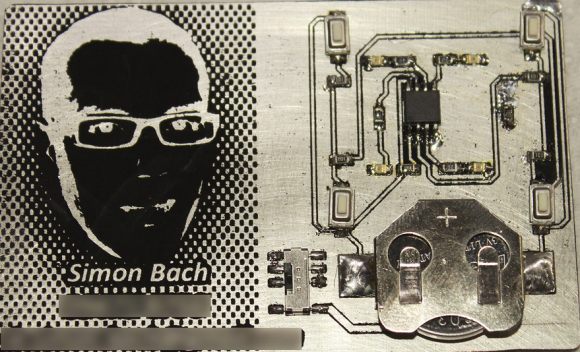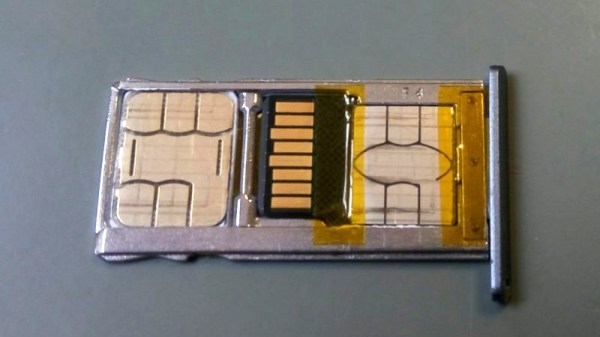
Adafruit Industries just announced their next kit: a SIM card reader. Using the kit, you can read or write any SIM card. You could use this for fun things like recovering deleted contacts and SMS messages. The kit looks like a very straight forward design (based on [Dejan]’s work); the only chip is a hex inverter and the board is powered by a regulated 9V battery. With all through-hole components, it should be easy to assemble. You can talk to it using the board mounted serial port or connect to the extra pin header using an FTDI USB cable just like the Boarduino. The FTDI option is bus powered, so you won’t need the battery. [ladyada] has collected some resources in case you want to learn more about smart cards.
Dual-Port RAM For A Simple VGA Card
Making microcontrollers produce video has long been a staple of hardware hacking, but as the resolution goes up, it becomes a struggle for less capable silicon. To get higher resolution VGA from an Arduino, [Marcin Chwedczuk] has produced perhaps the most bulletproof solution, to create dual-port RAM with the help of a static RAM chip and a set of 74-series bus transceivers, and let a hardware VGA interface take care of the display. Yes, it’s not a microcontroller doing VGA, but standalone VGA for microcontrollers.
Dual-port memory is a special type of memory with two interfaces than can independently be used to access the contents. It’s not cheap when bought in integrated form, so seeing someone making a substitute with off-the-shelf parts is certainly worth a second look. The bus transceivers are in effect bus-width latches, and each one hangs on to the state while the RAM chip services each in turn. The video card part is relatively straightforward, a set of 74 chips which produce the timings and step through the addresses, and a shift register to push out simple black or white pixel data as a rudimentary video stream. We remember these types of circuits being used back in the days of home made video terminals, and here in 2024 they still work fine.
The display this thing produces isn’t the most impressive picture, but it is VGA, and it does work. We can see this circuit being of interest to plenty of other projects having less capable processing power, in fact we’d say the challenge should lie in how low you can go if all you need is the capacity to talk 74-series logic levels.
Interested in 74-series VGA cards? This isn’t the first we’ve seen.
Cramming Dual SIMs & A Micro SD Card Into Your Phone
There are plenty of dual SIM phones on the market these days, but most of them are a hamstrung by packaging issues. Despite their dual SIM capability, this usually comes at the expense of the microSD card slot. Of course, hackers don’t accept such nonsense, and [Tweepy] went about crafting a solution. Sadly the make and model of phone aren’t clear.
It’s a simple case of very carefully shaving both the microSD card and the nano-SIM down until both can fit in the card tray. The SIM is slimmed down with the application of a heat gun helping to remove its plastic backing, saving precious fractions of a millimeter. The SD card is then filed down to make just enough space for the SIM to fit in underneath. Thanks to the springiness of the contacts in the phone, it’s just barely possible to squeeze both in, along with some Kapton tape to hold everything in place.
Your mileage may vary, depending on the construction of your SD card. Overall though, it’s a tidy hack that should prove useful to anyone with a dual SIM phone and limited storage. We saw a similar hack a few years ago, too.
[Thanks to Timothy for the tip!]
A Simple POV Business Card
The business card is an odd survivor from the past, when you think about it. When a salesman in a Mad Men style suit stepped out of his Studebaker and walked past a room full of typists to the boss’s wood-paneled office, he would have handed over a card as a matter of course. It would get filed away in the Rolodex.
These days, making your card stand out from the crowd of print-shop specials has become an art form. In our community this extends to cards with integrated electronics, such as this one with a persistence-of-vision display driven by an ATtiny from [James Cochrane], shown in the video below. It’s by no means the first such card, but he takes us through its design and construction in great detail which makes the video below the break worth a look. If you have never made a toner transfer PCB for example, you can see how his was made.
He makes the point that while a POV spinner needs only to display in one direction, a card has to be waved back and forth. Thus it needs to change the direction of its display, and needs a tilt sensor to activate this. His construction method uses through-hole components, but is surface mount in that they are soldered to the top surface of the board. The result is a rather attractive POV card that maybe isn’t something you’d hand out to all and sundry, but perhaps that’s not the point.
A Business Card That Plays Simon Says

When your name is Simon and you want to build your own circuit board business card, it makes perfect sense to incorporate a game of Simon Says, and that’s exactly what [Simon] did with his Business Card.
You may see a resemblance to the Engineer’s Emergency Business Card; that’s because [Simon] took inspiration from that card to build his own. The game of Simon Says is played via 4 low-profile pushbuttons and 4 0805 LEDs. The microcontroller of choice to run the game is an ATtiny45 set up to work with the Arduino IDE. But with only 5 pins available for I/O, [Simon] had to give up 4 pins to the LEDs and configure the remaining pin as an analog input. The buttons are tied into a voltage divider that feeds the analog input, so depending which button is pressed, a different voltage is read in, thus a value from 0 to 1023 determines which button was pressed.
One of the great things about this write-up is that it goes through the process of etching PCBs at home using the toner-transfer method. We’re not sure how many home-etched business cards he’s willing to pass out, but surely whoever does get the card, will never forget his name.
Surprisingly Simple Magnetic Card Spoofer

[Craig’s] magnetic card spoofer is both simple and brilliant. There are two parts to spoofing these cards and he took care of both of them. The first part is getting the actual card data. He designed the spoofer board with a header that connects to a card reader for doing this. The second part is the spoofing itself, which is done with an electromagnet. As with past spoofers, he wrapped a shim with enamel-coated magnet wire. An old knife blade was picked for its thickness and ferromagnetism. This magnet is driven by an ATtiny2313 which stores the data, and is protected by a transistor driving the coil. There were a few design flaws in his board, but [Craig] was able to get the same track data out of the spoof as the original card despite the LED being used as a protection diode and an ‘aftermarket’ resistor on the transistor base.
Cheap DIY Button Pad Uses Neat Punchcard Trick
A StreamDeck is effectively a really cool box full of colorful buttons that activate various things on your PC. They’re fun and cool but they’re also something you can build yourself if you’re so inclined. [Jason] did just that for his sim racing setup, and he included some nifty old-school tech as well.
An ESP32 is at the core of the build, listening to button presses and communicating with the PC. However, the build doesn’t actually use regular buttons. Instead, it uses infrared sensors wired up in a matrix. This was an intentional choice, because [Jason] wanted the device to be reconfigurable with different paper card overlays. There are ways to do this with regular buttons too, but it works particularly well with the infrared technique. Plus, each button also gets a Neopixel allowing its color to be changed to suit different button maps.
What’s really neat is that the button maps change instantly when a different overlay card is inserted. [Jason] achieved this with an extra row of infrared sensors to detect punched holes in the bottom of the overlay cards.
Once upon a time, even building your own keyboard was an uphill battle. Today, it’s easier than ever to whip up fun and unique interface devices that suit your own exact needs. That’s a good thing! Video after the break.
Continue reading “Cheap DIY Button Pad Uses Neat Punchcard Trick”















